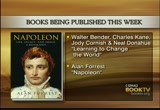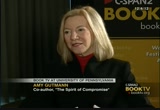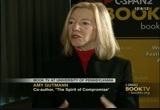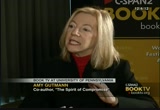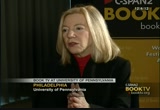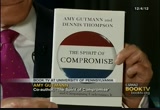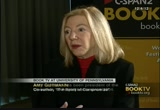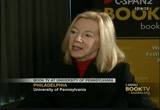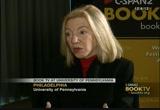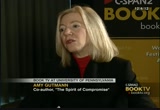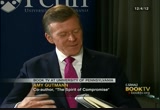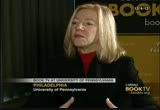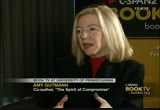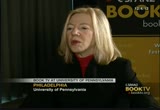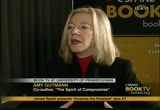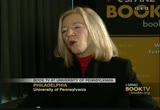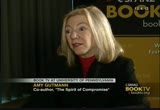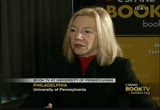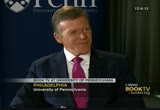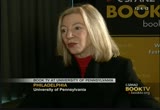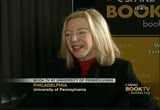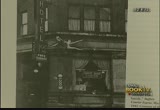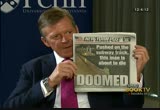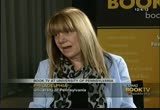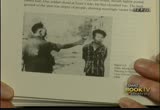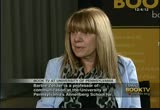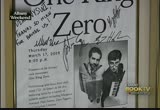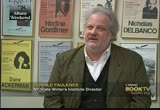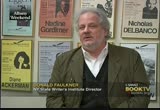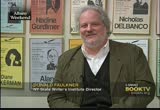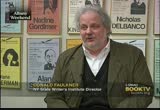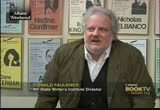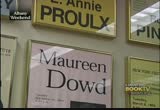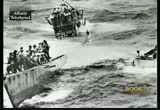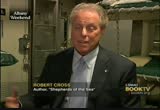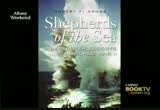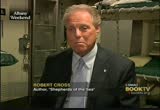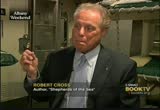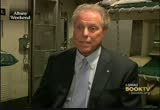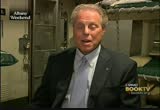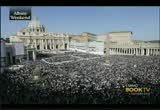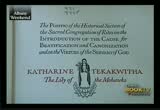tv Book TV CSPAN December 9, 2012 1:00pm-2:00pm EST
1:00 pm
york recounts the life of french military leader and emperor, napoleon bonaparte. and author helen bynum details the infectious disease tuberculosis in spitting blood, the history of tuberculosis. look for these titles the bookstores this coming weekend watch for the authors in the near future on book tv and on booktv.org. >> you're watching book tv. now, president of the university of pennsylvania talked to book tv about her latest book, the spirit of compromise. she also talked about her role as president of the university. this interview recorded at the university of pennsylvania in philadelphia is part of book tv college series and it is about 20 minutes. >> well, you're watching book tv on c-span2. one of the things we like to do on book tv his visit college campuses. we can talk to professors who are also offers and a showcase
1:01 pm
of books that you may not know about of the lines. we are pleased to be at the university of pennsylvania in philadelphia this week, and we are joined by the president of the university dementia is the co-author of this book, the spirit of compromise, white governing demands it and campaigning undermines it. president, are we a politically compromising nation? >> we were created in compromise. a lot of people think of the revolutionary war, which separated us from our mother country, but if you recall, i know you weren't there then, but if you recall it -- historically speaking our founding fathers crafted a compromise that created the constitution. they were as polarized as any set of americans who had been throughout our country and history. there were a pro and anti
1:02 pm
slavery and yet they compromised. so, yes, we were founded in compromise. today compromise has become more difficult than ever before. >> what do you mean when you talk about the uncompromising mindset? >> well, we live in an era that has been characterized as a permanent campaign where every day is election day. and campaigning and elections make for uncompromising line sets. you stand on your principles to mobilize your base, draw in endless amounts now of money. the 24 / seven news cycle covers politics as if it is a horse race in the horses are on steroids in this terrorist of the money is coming in to fund the campaign. so what we mean by the uncompromising mindset is a mindset that is geared toward elections and not toward governing. >> you right in this by you and your co-authored, as we observe
1:03 pm
the changing scene in american politics we came to believe that the general problem could be addressed by concentrating on a particular institution, the united states congress. >> well, if you wanted the problem with the uncompromising mine says, look no further than the congress, the 100th of congress in washington. gridlock, nothing gets passed. the least of legislation and the last 50 years. why? because everybody is campaigning all the time. there is very little by way of relationships across the aisle. and we went out to the brink of the debt ceiling crisis before. compromise was reached which was routine in the past. so we thought that by focusing on the problem of congress whose popularity is at all-time lows.
1:04 pm
john mccain said, you can account for that 9 percent popularity of congress during the debt ceiling crisis by blood relatives and paid staffers. we saw it by focusing on congress weekend above the diagnose the problem and give some prescriptions for how to overcome it. >> what is one of those prescriptions? >> well, one of those prescriptions is very simple, which is, congressmen need to exercise mixing mind sets, by putting aside the campaigning mindset long enough to govern. and adopting the compromise might said. in order to do that they have to have relationships. so they should spend more time in washington and less time raising money. people we will say, oh, but that is going to hurt them in the next election. well, what we say is that politicians to enter politics just to be stand on principle.
1:05 pm
very few people think politicians -- attracted to politics because there were the responsible people. there were attracted to politics because they want to govern, so it takes lead. takes relationships. we have this phrase which is familiarity leads attempts. it is no accident, that ted kennedy and orrin hatch crafted compromises. there were both strong partisans, but they had the spirit of compromise. then makes the mind set. that is our main description to five prescription for compromise >> but if you consider hatched he was pretty well fed by the tea party with a primary and potentially being ousted from office because of some of this compromise is. >> true. and we don't -- compromise is difficult. governing has become more and more difficult. however, if politicians, what do we remember warren has for? we robber and for passing grade legislation to protect children's health care.
1:06 pm
we are not calling to remember politicians for their cowardice. we will remember them for their courage. i should say we're not going to run them positively for the cowboys to a cowardice, but for the courage. we are calling on politicians to exercise. we also talked about a set of reforms that would make it easier to compromise. performing a filibuster, open primaries rather than close primaries. limiting the amount of money. the problem is you can't get these reforms without compromise, so we all have our favor reforms. politicians need to mix the mindset and lead. and to that is eminently possible. >> you right on restraining the rhetoric, a third strategy of economizing on disagreements is designed to deal with the fact that this agreement will persist on most issues, the democratic process is not always or even usually real, let alone general
1:07 pm
consensus. what do you mean by economize? >> well, what we mean is that we have a polarized politics right now. and if each side stands on its favored principles we will get no compromise, no deal. we will get gridlock. we will get economic disaster. and economizing on your principles means finding places where you can concede something to the other side by finding ways in which your principles intersect with there's. this is what some people call common ground. what we are saying is, it's not all common ground. it is agreeing to things that the other side believes in that are consistent with moving the ball forward according to your own principles. so we do this all the time when we make deals outside of
1:08 pm
politics. you look so what is most important for you to gain and you also give something to the other side. >> so the president of the united states have all role in this compromise? >> the president, that you are going to ask the president. the president of the united states definitely has a role. and, again, the president has the point in the direction of his and his party's principles, but the president also has to show, by words and deeds that he is willing to make a good compromise. and i believe president obama has. >> how so? >> well, the president has said and reached out across the aisle on various things with regard to economic reform, tax reform, immigration reform. i think -- well, i don't have a crystal ball.
1:09 pm
i think that there is little doubt that the president would be willing to compromise if the other party is willing to meet him part of the like. the other party has a job to see how much it can get for its site , and given, you know, the issues we have been through, such as the fiscal cliff, the fact is there is no way out of these issues without compromise. but i do think we will see compromise on something like immigration reform because demographics, the republicans as well as the democrats recognize that there has -- they have to show some support for immigration reform if they are not going to in the case of the republicans. lose the hispanic population permanently to the republican party. so the president has already shown willingness to compromise.
1:10 pm
and all of the data shows that republicans are the party that has moved further to the right and the democrats have moved to the left, although both parties have moved to the extremes. so i think we are going to see the president, because he won the election, being tougher rhetorically about not compromising, although saying that he is open to compromise in order to see how far the republicans are willing to move. >> we are taking this interview in the middle of the so-called fiscal cut debate. how do you see january 1st -- how would you like to see january 1st, but? >> well, it was clear that the vast majority of americans, and i'm with the vast majority of americans on this, would like to see a compromise before the end of 2012. otherwise a lot of bad things
1:11 pm
will start to happen. it is clear to me -- it's not clear whether there will be one, although both sides stand to lose if there isn't, and that's a good recipe for compromise. but it is clear to me that if there isn't a compromise before, there will have to be after. some batters in an atlantic. >> does the president of the university of pennsylvania, does the ceo, the family member have to compromise on a basis? >> absolutely. has to compromise, whether on a daily basis, don't want to compromise. one shouldn't want to compromise one should be willing to compromise when necessary to achieve one's goals. and that is true in personal relationships as well as in politics, and it is certain natural time in the professional . edwin burke, the great conservative philosopher said
1:12 pm
all human relations are based on compromise. and i think he's right. >> back to the spirit of compromise. one problem with rejecting compromise in the hope of a better one to come is that the rejection of self becomes an obstacle to reaching the future compromise. >> yes. that is so true today of our politics. but continual rejection of compromise and the continual demonization of one's political opponents in the campaign has made compromise very difficult, even when it's entirely and absolutely and obviously necessary. >> what about the supreme court? did they ever compromise? >> one of the interesting things about the supreme court is that while they give reasons for their opinions, we don't get a window into the back chamber
1:13 pm
negotiations. bat, and indeed the 5-4 decision on affordable health care act where it chief justice roberts cited with the four liberals on the court, many people think there have been a compromise. now, whether the justices would never speak of it as a compromise is doubtful, but if you look at how the justices came down and the pressure to craft a majority opinion, it is very plausible to think that that decision was a compromise between the reciprocation of the commerce clause and upholding of the affordable care act. and many other decisions, close decisions on the court look like compromise. >> to his dennis thompson? >> dennis townsend is my wonderful co-authored it is a professor to of political
1:14 pm
science and political philosophy and art. many years ago when we were both at princeton university week co-taught a course on ethics and public policy, and that led to as co-operate several books on deliberation and democracy. >> in the spirit of compromise, you give it to legislate examples. 1986 tax reform health care act. if you would, walk us through those. >> so this is a tale of two compromises. and it begins with ronald reagan presidency where tax reform was a huge and important issue and a hugely difficult issue to get done between the republicans and democrats. those of us who lived through the reagan era recognizes that people thought they were very
1:15 pm
polarized. tip o'neill was a staunch little too liberal democrat and reagan's staunch conservative republican. yes, they crafted a bipartisan compromise. part of the movers of that compromise. test for to the affordable care act. it ven more difficult to craft a compromise within one party, the democratic party, because of the permanent campaign and helped not just polarized, but resistant to compromise the two parties were. so the comparison between the tax reform act and the affordable care act helps us see how much more difficult compromise now is and how much more important it is for two parties to get together to craft the kinds of compromises on immigration, tax reform, many
1:16 pm
other issues that the country now needs. >> was there or is there a golden age of compromise through real crises, world war ii, september 11th, let themselves to compromise? political compromise? >> compromise is always tough. and the way we should judge the ability of our politicians to compromise is, what are they great goals that they have succeeded in getting that they could not have without compromise? so the golden age, there was one, and i am inclined to think, there was never a golden age, but there was a very important age of compromise which founded this country, so i would go back to the constitution. for all it's worth, and it had more than a war. it had an evil bake into it, the
1:17 pm
evil of slavery. the constitution was made, if possible, to abolish slavery. you have per member, it was the articles of confederation that preceded the constitution and with them every state had a veto power over all legislation. so it was actually the establishment of the constitution of the united states that was established and made the abolition of slavery ultimately possible. >> speaking of compromise, if the fiscal, so-called fiscal closed talks to not come to any kind of a conclusion, it is implemented, have you looked at how you're going to have to compromise in pennsylvania, how it will affect the university of pennsylvania? >> yes. if we were to go over the fiscal cliff, and even more so, if there isn't a compromise that
1:18 pm
really establishes the american financial system on solid ground , then there will be many ways in which we as a university and every university in this country will be compromised. in the sense of compromising our quality. we will -- we depend upon the funding of biomedical research, innovation in this country. that will dry up. we are committed to making an affordable for all of our undergraduates with costas about $181 million per year. that is twice the amount it cost us eight years ago because we have rant of financial aid. and the more unemployment there is in this country, the more we spend on financial aid. and it would be a tragedy if this country moves in a
1:19 pm
direction to make education less affordable. so we, as a university, are very dependent and very concerned about the fiscal health of this country. >> are you also in the class from parent university? >> i do enjoy teaching. and i take every opportunity to meet with students, to talk to students, and to teach in my spare time. >> what does a provost do and how long were you at princeton? >> i was at princeton for 28 years from the time i got my ph.d. until the time i came to pan and i was on the faculty at princeton and also provost, the chief academic and chief financial officer at princeton, so the proposed works very closely with the president. >> what is the learning curve on being president of the university? >> well, the learning curve is
1:20 pm
steep for anybody, and it is also very exciting. >> how many students, give us -- >> the university of pennsylvania has 10,000 undergraduates approximately into a dozen graduate students. we have about 4500 faculty members. we run three hospitals. we have a great school of medicine as well as the great school of arts and sciences and ten other schools. we have 32,000 employees. the largest private employer in philadelphia commandery like to think of ourselves as ben franklin's university. the university which was an elite but not elitist. not an ivory tower. we believe in integrating knowledge to maximize social impact, and we are an economic engine of innovation for our city, for our region, and for the country in the world. >> is this the original
1:21 pm
location, where we are? >> no. we are in university city in west philadelphia. pan originally started in what was then a very small downtown city of philadelphia, and been moved to west philadelphia and will we call university city which we have helped make into a very vibrant arts and culture and economic hub. >> and once again, here is the book. it is the spirit of compromise, governing demands it and campaigning undermines it. this is book tv on c-span2. >> every weekend book tv authors -- offers 48 hours of programming focused on nonfiction authors and books. watch it here on c-span2. >> on your screen is a photograph taken in 1942.
1:22 pm
buffalo, new york. university of pennsylvania professor, what are we looking at? >> via looking at a woman who committed suicide out of a hotel in buffalo during the year, and a photographer happen to be passing by and took the picture. the picture appeared in life at the time and one widely acclaimed awards for having been able to capture the moment as the person died, the moment with the person was about to die. and this is really the start of a whole tradition, a whole legacy of those of people facing death that have cluttered our news faces ever since. >> now, you use the word cluttered. what is the value of seeing that picture of the woman jumping? >> the value of a picture like that as it pulls us in subjectively. it is a very emotional picture. very dramatic, very memorable. poles and all kinds of motions for which we are able to engage the event. the a news event it is actually
1:23 pm
depicting, and this is important because not only do we want to understand why we're seeing, what we want to feel important things about what we're seeing like to fear feel -- feel fear, anguish, compassion, sentimentality, all kinds of things that helped drive the news for us and make it important. >> well, i want to compare that although we just saw to a recent new york post front-page photo. what are we looking at? >> this actually came at just this morning. this was a gentleman from queens who was pushed off of a subway platform and a photographer, a freelance photographer for the new york post happened to snap his picture. and that think that these pictures actually illustrate very well where we have come in terms of our public sentiment and a professional sentiment about pictures of people facing death it. whereas the first picture, 1942, won awards, it generated tremendous a claim for the
1:24 pm
photographer, it is taught in photography courses as the kind of picture that people want have in the news. this picture, and the photographer and a newspaper or widely critiqued. people have been saying all day, and has been all over the blogger is here. what were they thinking? why did this photographer take this picture? why did he run away? why did he help? market that newspaper actually show the picture? why is it putting in on its front cover? there is a gap in public sentiment above what these pictures mean and what they're supposed to difference in connecting. >> to this gentleman on the tracks by? >> the gentleman did die. fat, the photographer was criticized for not having helped the salomon get up from the subway tracks. anybody who knows anything about gravity does that it is very difficult for one individual to pull somebody up from the tracks. there were multiple of the people standing on the platform, and the photographer was reduced to the point of saying that he
1:25 pm
had actually taken the picture so as -- for his flash to let the conductor to stop the train, which is a ludicrous excuse, but it shows the degree to which he was feeling criticism for having taken the picture to begin with. >> as a professor of communication here at the university of penn, what is your reaction to the photographer? what do you say? >> my reaction to the photographer is my reaction to all the photographs that appear in my book that depict pictures of war, pictures of terror, pictures of natural disaster. all of which have been capsized in this moment of people facing death, and my argument has long been that if they're willing to read the news about these events, we should be willing to see the pictures of these events the pictures do different things, but there are no less important as vehicles of affirmation relayed and other words. so as long as we keep saying, i
1:26 pm
want to know about this event, but i don't want to see pictures about it, we are not privileging , not excepting, not recognizing how images bring us into the news in a way that is different from words. >> well, someone argue that this image we are about to show here in about to die is very different than an image of a man on a train track are a woman jumping out of a building. what are we seeing here? >> we are seeing here is a kevin carter image that was taken in the sudan of a small child faugh it was dying of starvation and a vulture sitting in the background of the shot waiting to jump to spray. this photograph, i agree, is qualitatively different, although it certainly does fit into the larger moment of pictures of people facing death and their capacity to draw us into the news. this picture, of course, at the time one again many awards.
1:27 pm
it appeared in time magazine. and then the criticism started coming. in started coming fairly in terms of critiquing carter for not having helped the child. there were many that came at time magazine and said, what happened to the child? where the child go after the picture was taken? and, of course, carter was not able to provide answers. there were many erroneous answers that were offered first. it was said that the child it moved to safety at a feeding center. and it was said that he had picked the child up. then it was said that he didn't pick up the child and he went and he said net tree and cried. and, in fact, the following year after he received awards for the fellow he committed suicide. the legend went in newspaper lord that he committed suicide because he can handle the critique that was leveled against him for having taken a particular freda to be that as a way of saying that these photos
1:28 pm
are not easy. they're not ease its stake i think there are important >> i want to go back to the new york post. would you have taken this photo? >> absolutely. i don't think that the question of what i have taken that showed up is a question that any photographer really asks him or herself. if the news is occurring the news is taking place, you recorded and your record it with whatever is that -- device you have available, whether it's words or pictures. when i have tried to do in this book is generate a more empathetic understanding of why pictures are important on their own terms. >> very well known picture right here. >> this is the picture, the shooting of general during the vietnam war. this was a picture, also problematic, as are most of the pictures in this book. this is a picture in which the
1:29 pm
general was shooting a suspected vietcong prisoner. and the picture came out, was widely, widely admired, widely recognized and intensively generated discomfort for eddie adams, the photographer who had taken it. the argument was that -- would be argued is that taking that one picture against the other pictures created a criminal out of the general who was actually doing the shooting. give him notoriety committed very difficult for him to live a so-called normal lives after the fact. and the argument, of course, is that these pictures, because they slice a very particular moment out of the largest accounts of action, there always is some kind of tension about what they actually depict verses what actually more generally happened.
1:30 pm
>> professor, public policy issue that we have been facing. fallen soldiers even a riding in the caskets, should those images be shown? i would say absolutely. nothing but what has happened is the reason why a picture of somebody facing death has become so prevalent and i argue that it appears across the landscape. .. aho
1:31 pm
>> host: professor barbie zelizer who is a professor of education here at the annenberg school at the university of pennsylvania, published by oxford. "about to die," is the name of the book, "how news images move the public." this is booktv on c-span2. >> is there a nonfiction author or book you'd like to see featured on booktv? send us an e-mail at booktv@c-span.org. or tweet us at twitter.com/booktv. >> now, from new york, the writer's institute promotes cultural initiatives through author presentations, workshops, film screenings and more.
1:32 pm
>> i can see each event just as vividly as i can see the posters before me. i'm donald faulkner, i'm director of the new york state writer's institute, and what we do, what i do is kind of herd intellectual cats. we bring a lot of writers through to albany to do readings, we also do a number of other types of programs, events, writing workshops and film series and programs with young writers and a summer institute that we run in saratoga. >> the life of the writer, my life in the last few years was, i suppose you'd call it adventurous. but this thing ruined everything. [laughter] >> we go far and wide, find the best writers that we can and bring them to albany. it's like bringing the world to a particular place. and i don't think -- i can't think of any other organization, even some of the better known ones in major cities that have
1:33 pm
such a regular flow of creative talent coming through and at no cost to the public with our open door policy. so we bring the literary world to albany. so all these people whose names, faces and dates, events you see are people who have come from far and wide to read to the general public here. and we've had somewhere -- my most recent count now has gotten us up to at least 10 or probably 11 nobel laureates across the years ranging from toni morrison who actually used to teach at albany to, most recently, a south african writer. and along the way, i don't know, people like the nigerian writer, wally -- [inaudible]
1:34 pm
or the caribbean writer derek walcott or the irish poet, seamus haney or -- the names go on. but along the way we archive all of the, by video and audio, all of the people who have come through. so we have left a footprint, they have left a footprint, and the institute was founded in 1983 but officially became the new york state writer's institute in 1984, and over the years we've had more than a thousand writers through. >> my sister was a rabid conservative who, actually, worked at w's first convention. and, um, she couldn't get a room, so she ended up having to stay with me, and she brought a sign she was holding that said "w stands for women."
1:35 pm
[laughter] and i said, you can say but the sign has to go. [laughter] >> as a result, we have a very extensive archive of those writers, their readings, interviews with them, and i guess we like to think of ourselves as perhaps becoming the c-span of literature. i don't know, we'll see what happens with that. but we're about to roll out what is, in essence, a kind of virtual research library of all of these videos and audios that we've collected over the years. we're told by many people it's the thorough-going archive of contemporary writerring that they -- writing that they know of in america. one of the things that helps is to be writers ourselves and to know what makes a writer comfortable, to respect a writer who has come for a visit and not treat that writer like some sort
1:36 pm
of circus side show and to engage that person in conversation. we often like to say and joking among ourselves that we invite writers to dinner, and we just have these couple of public events on either side of the dinner or some gathering after one of those public events. but what really happens is sitting down and having good conversation. it brings writers back. it's actually one of the things that people, i think, most appreciate about the writer's institute. writers will be respected as writers. i remember one writer saying, you know, you go to some literary readings, and you think, gosh, i'm so glad i got through that. let me, you know, catch the next plane out. you go to the writer's institute, and you find yourself saying, wow, that was good. i hope they invite me back.
1:37 pm
>> mom and dad were high school teachers, and we would take family vacations across the country. and instead of going to seaworld and disneyland, we would visit historic sites. by the time i had turned 15, i had visited jefferson's monticello or truman's independence, visited steinbeck's home in salinas, i was able to go to the reed willow cabin and go to red cloud, nebraska. so i think living on the road for family vacations three months in a trailer got me very interested in american history. >> with literature comes very important thing; community. as one old friend used to say, a writer is someone who has readers. i always thought that was a good, simple line, a good, simple definition of what a writer is. but that effort of creating a community through an art form and enhancing that community, enhancing that general
1:38 pm
imagination makes having the writer's institute not only a worthwhile thing, but i think a very important thing. and what we've done, i think, across the years is we've not only exposed people to excellent artwork and writing in particular, but we've educated people. to become more discriminating, to become more effective judges of what makes something good. and people read, people buy books. this is a very book-loving community, and i think the writer's institute has done a lot to, um, enhance that even on some level create the environment in which people can explore literature especially. i think that there aren't enough programs like this around the country. i wish there were more. the literary community in albany is quite rich, and we're in kind
1:39 pm
of feedback loop with it. i don't think such an operation as the writer's institute could have been created in the first place without there being not only a strong group of writers, find sort of an arc from down toward columbia county where a lot of new york city writers have weekend homes all the way up to saratoga and beyond. we have places like yado, the writer's colony there and writers' groups in hudson, new york, east and west into western massachusetts and west to syracuse. that's the audience sort of circumference that we work with. so when you go back and you find a general population quite proud of albany's connections to henry
1:40 pm
james and herman melville or even brett hart -- a story writer -- or just, you know, a little bit further east over to wave to emily dickenson or a little bit further south to say hi to our old friend walt whitman or edith wharton. when we have this sense of the cultural heritage, it helps to amplify writers' own senses of, you know, being part of a larger story which i think is quite important for the whole sense of literary tradition. so there's this rich ground that's here already. and then the writer's institute comes in and becomes a beacon, it becomes a magnetic pull, it becomes a resource if nothing else, and it may make the rest of that sound too high that
1:41 pm
luten. but it becomes something that feeds the whole system. it gives fuel. it's fuel to the fire of people's imaginations. and it's very rewarding to see that, to encounter that, to see people in our writing workshops really catch fire with their own creativity because they've been given stuff to work with, they've been challenged by excellence that they've been able to see themselves. >> next, we take a tour of the uss slater with richard ross. mr. cross describes the role these boats played in winning the second second world war. >> "the shepherds of the sea," and it's a book, basically, about destroyer escorts in world war ii and the men who sailed them. and destroyer escorts actually
1:42 pm
ended up being the most important, um, successful and valuable antisubmarine vessel in the united states' fleet during world war ii. they're credited with sinking some 70 u-boats, 26 japanese submarines, and they fought in every major battle in the pacific theater. so they were a very senate force in world -- significant force in world war ii. and what's even more remarkable to me is the people who were manning those boats. these are mostly teenagers with little or no experience on the water with. in fact, some of them told me that the only thing they knew about boats is that the pointed end went first. so they were a remarkable group of teenagers. um, they were very courageous, and they were being led by their skippers, and their skippers were ivy league college boys who were, you know, basically naval reserve. and they were more used to being
1:43 pm
aboard yachts than warships. they were sent out on these novel vessels, destroyer escorts, which were brand new and had never been tested before. the original idea was franklin roosevelt in 1940, he recommended that these vessels be built to deal with the continuing presence of the nazi u-boats in world war ii on the north atlantic. and winston churchill warned roosevelt and america that, basically, something had to be done to stop hitler's u-boats in the war before, as he said it, america -- the sea would become america's cage, cutting off all commerce between the united states, england and europe. and so the president ordered them built in 1940, but the navy, um, decided that that was probably not a good idea. so they convinced the president that the scarce resources that were available at that time would be better spent on destroyers. and i think that if you look at
1:44 pm
the historical record, you'll see that that probably was a mistake. the destroyer escort is sort of a novel type of vessel. it's smaller than a destroyer, um, around 300 feet. and it had a shorter turning radius so that it could, it could essentially turn on a dime compared to a destroyer. so what they did is they escorted the convoys across the atlantic, and the convoys consisted of troop ships and supply ships for the war effort. but if they, if they made contact with a u-boat, they could break off, and then they could pursue that u-boat. when you look at the record, though, i mean, 70 u-boats, they probably were, without question, the most successful antisubmarine vessel in the fleet. this ship is the uss slater. it was built in the tampa shipyard. there were 563 destroyer escorts built, um, in 17 shipyards all
1:45 pm
across the country. it actually came late in the game, like a lot of them. this is 1944. they did a few escorts back and forth across the atlantic, and one interesting thing that they, that the slater did do, um, the only nazi submarine, the only u-boat captured by the americans in world war ii was captured by destroyer escorts. they got a treasure-trove of material, confidential documents, actually a half a ton from this u-boat, u-505. and one of the torpedoes was actually loaded onto the slater and brought back to america for study. along with the all-important enigma machine. and that was the code-breaking machine, and it actually was very useful because it came on the eve of the normandy invasion, um, and they were able to actually, um, take that off the u-505, bring it back to
1:46 pm
america and was very helpful in breaking the german code. one of the sailors who was going through this u-boat -- now, most of these sailors had never been aboard a submarine at all, let alone a german u-boat. so they were storming through, looking for -- and meanwhile, the u-boat is flooding because before the germans went overboard, they opened up the valves so they could flood this because they certainly didn't want the americans to get any of the materials and the confidential documents that they did, in fact, end up getting. so he's running through the passageways, and he goes into the captain's quarters, and he, he opens the -- rips open the captain's desk, and he finds a mont blanc pen, and he thinks, well, this is kind of a nice treasure. if you found something, because this was a top secret mission, you were not allowed to keep it. but he kept it anyway. years later, it ran out of ink.
1:47 pm
so he contacted the company and said, you know, would you have a refill for this pen, and he told them how hold it was, and they said, no, i'm sorry, we don't have any refills for this pen. and they said with where did you get it? and they said, well, we'll send you a brand new pen, which he didn't do. he donated it to u-505 which is now a museum. i interviewed 91 sailors and officers from 56 different ships, so that's about a tenth of the fleet. and i could have done a lot more, but at some point you had to stop because you'd never get your book written. so an interesting thing about -- that was interesting to me is, um, how patriotic the young men were back in those days. after pearl harbor everyone wanted to join up, everyone wanted to be in the military. so you would, they would lie about their age, they would forge birth certificates, they would do a variety of things just to get into the military.
1:48 pm
and this one sailor from new jersey, um, wanted very badly to get into the military after pearl harbor. so his problem was, though, he had very bad eyes. and he knew at that point he couldn't pass any of the, any of the tests that would allow him to enter any of the branches of the service. so he was also a very avid reader, and he read popular science. and he noticed in addition to popular science that there was this experimental program called invisible eyes. and it was a program that was sort of a precursor to the contact lenses. and so he got on the train, went into new york, got enrolled in the program, and, um, got his set of invisible eyes. so he went to the recruiting station and watched how they did the examination. well, he watched the navy, and the navy had one line. so you would go down the line, and you would get your physical
1:49 pm
exam, you'd get your psychological exam, and then your eye exam. he said he knew he couldn't get in that line. so then he watched the coast guard, and the coast guard had two lines. the first one was for your physical exam and your psychological exam, and then if you passed that, they told you to get into the other line for the eye exam. so he figured that would give him just enough time to slip the contact lenses in his eyes, which he did. and the recruiter said read the bottom line, and he said how far down? and he said as far as you can read. and so this sailor read p, a, t. and he said what are you reading? he said, i'm reading the bottom line. and he said, you're reading patent pending. so you clearly have eyes of an eagle, so, you know, you're in. and that was just how so many people, so many of the sailors that i interviewed, i mean, and they did it because of patriotism, they did it because
1:50 pm
it was the right thing to do, and we sent them to sea in these new and untested vessels that the navy thought initially was a colossal waste of money. no warship had ever been manned by an african-american crew, and the first warship to be manned by an african-american crew was the uss mason which was a destroyer escort. franklin roosevelt wanted to do something to end racial discrimination in the military and in industry, and, of course, he was a pragmatist. and he was also a shrewd politician. and he knew he had to be very careful, otherwise he'd alienate some of the southern political folks that just didn't have that same view. eleanor roosevelt, on the other hand, was a very strong proponent of equal rights and of doing something to end racial discrimination. so she continually prodded franklin roosevelt to do something. so he decided that he would, um, have one of these new destroyer
1:51 pm
escorts be manned by an african-american crew. white officers, but an african-american crew. they went off in the battle of the atlantic, did some heroic things and, in fact, they were recommended -- the crew was recommended for a navy commendation by their white captain. well, the navy didn't want these people in the first place, and so they decided they weren't going to give them the commendation. so the commendation was not given to the surviving crew members until almost 50 years later. president clinton, actually, was the person that gave them the award. if you look at this ship and you think about it, you think over 200 people in the space of 35 feet wide and 200 feet -- 300 feet long, it's pretty, pretty tight accommodation cans. and if you look here in the bunk room, you'll see that there really respect enough bunks for -- aren't enough bunks for
1:52 pm
all the people. so it was a tough situation, especially they would be out on the water for months at a time, and they were smaller ships. so on the north atlantic it could be a very difficult situation out there. i had some photographs that show the ships actually completely ice-encrusted, and they would just, you know, move around on the water with great difficulty. but they, they survived. after the war, you know, some of them were scrapped, and some of them were given to other countries as part of our president truman's, the truman doctrine. which, you know, was to provide these type of vessels and other military aid to other countries. so this particular vessel went to greece. and it was their number one vessel for a long, long time. and until about 1991 when the greek government decided they no longer needed this vessel.
1:53 pm
within a very short period of time, the destroyer escort sailors' association raised nearly $300,000 to have it towed back to america. it was housed for a short time at the intrepid air, sea, space museum in new york city. when they no longer had room for it, they had to search for a new home, and fortunately, mayor jennings -- who's the mayor of the city here in albany -- felt this would be a wonderful attraction on the waterfront which he was trying to revitalize at the time. and now it's, it's the only destroyer escort still afloat in america in its original world war ii configuration. this is the kind of thing that allows people to see what it was like back then, why there was world war ii and what happened, um, and how valiant the sailors were who served aboard these vessels. it is, it's a remarkable testimony, i think, to the brave ri of the men back in those
1:54 pm
days. >> albany, new york, is one of of -- next, we hear from jack casey. his book tells the story of katiri, a mohawk woman born in 1656 who was recently named the first native american to enter sainthood. >> well, lily of the mohawks is a name that was given to a young woman. she was baptized by the jesuits, and she took the name katherine which has been anglicized from her culture into katiri. and she's called lille ri of the mohawks -- lily of the mohawks because she's seen as blooming in a land from the bloodshed of the martyrs that preceded her. there were three or four martyrs in that land, in the mohawk
1:55 pm
valley about ten years before she was born. so she is a lily that has bloomed out of that sort of spiritual effort by the jesuits in the 17th century. so she escaped. and she went up near montreal. there was a mission up there, st. francis xavier mission. and she came to the attention of a priest named father claude, and he was a sort of a spiritual refugee from france. he was having his own spiritual dilemmas. and when he encountered her, he saw this incredible spirituality that was sort of unexpressed, and he was able to sort of draw can it out of her. and allow her spirituality, her mysticism, her deep devotion to jesus christ to sort of help him heal his own spiritual doubts. and i think together there was a confluence there of this spiritual energy which, i think, is a love story on a very
1:56 pm
high-refined level. it's sort of a divine love that, say, you or i wouldn't be able to appreciate. and they had this union, i suppose, where they sort of circled each other, and he observed her, and i think she observed him. when she died at the age of 24, it was april 17, 1680, immediately after her death her body was transfigured. and there are two written accounts which are in that book right there that was part of her cause over in rome. now, she's already passed away, and she was only 24 years old, and she was a recluse. she only had a couple of female friends that knew her really well but for the priests, and he started this curing, and she started affecting substantial cures. women in childbirth were having breach birth and that sort of thing, and he would apply dirt from her grave or pieces from her clothing, and they burned
1:57 pm
some of her garments and made a tea out of it, and people would drink it. and these miracles kept up until about 1760 when the english came in and took canada back or took canada from the french. and then everything ceased. the jesuits were expelled. i think some of them remained, but they were really, you you y, suppressed, catholicism was pup accessed. and they came back in the 1840s. in the 1840s they rediscovered her, and they got some of the manuscripts about her out of the around kentuckys, and they rekindled this interest in her, and she started affecting more cures. now, the miracle that prompted her, prompted the pope to canonize her in 2005-2006 there was a young boy, native american in the state of washington, near seattle, and he was playing basketball, and he fell down and hit his lip on the pedestal of the basketball hoop. and he was afflicted with the flesh-eating bacteria. and if you go online, you can
1:58 pm
either google her name or his name. it's jake finkbonner. they have pictures of him when he was in the throes of this malady. so jake finkbonner had survived. his surgeons were absolutely miraculous in the way they were able to graft skin to cover what had been consumed by the bacteria, and they attributed his survival, his cure to her intersession. so that was verified that supernormal or paranormal occurrences can only come from above. that was in '05 or '06 when he had that malady. and then they decided to canonize her last year, i think it was in december of 2011. and they put it forward on
1:59 pm
october 21, 2012, was the date of her canonization. a novelized biography is something where you take the facts, and you try to tell a story out of them, and you impute motive, and you try to get a human psychology that we can respect because we are alive, we have people that we've known and, you know, we know our own inner hearts. and you try to make it real. in a way that's sympathetic. and i don't mean sympathetic that it's, you know, soft-soaped, i mean sympathetic where you say, that's true. and that's true in a deeper way than just the facts. so you try to tell the story in a way that's inductive to the reader, where the reader's on the edge of his or her seat saying, oh, my god, what would i have done in this situation? and any great movie that you've been to, any great book that you've read, that's really the magic, i think. so a
176 Views
IN COLLECTIONS
CSPAN2 Television Archive
Television Archive  Television Archive News Search Service
Television Archive News Search Service 
Uploaded by TV Archive on

 Live Music Archive
Live Music Archive Librivox Free Audio
Librivox Free Audio Metropolitan Museum
Metropolitan Museum Cleveland Museum of Art
Cleveland Museum of Art Internet Arcade
Internet Arcade Console Living Room
Console Living Room Books to Borrow
Books to Borrow Open Library
Open Library TV News
TV News Understanding 9/11
Understanding 9/11